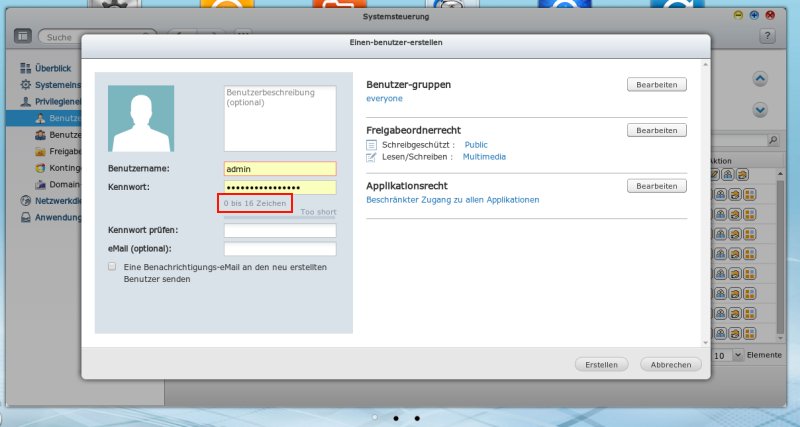The Raspberry and owncloud ran for a few months now and I really enjoyed my own personal cloud. But I was really annoyed by the poor performance. One possible solution was to switch the sd card, which I did. I replaced the Transcend 16GB SDHC card with a 4GB one. Performance is much better now. Since setting up the system is a pretty simple and fast process, I didn’t bother about cloning the card etc. I reinstalled raspbian and followed my own guide on how to setup nginx and php and oriented on my other tutorial on how to install owncloud 6 beta. Of course I needed to change some links etc.
Some more things (I) changed:
- owncloud added security for trusted domains
- moved owncloud storage to an external usb drive
- changed the nginx webserver configuration: restrict to https only and …
- accessing php-fpm through network socket
1. If you access the webinterface of your owncloud instance using different ips, names etc., you need to add them to the „trusted_domains“ parameter.
pi@raspberrypi ~ $ sudo vi /var/www/owncloud/config/config.php
‚trusted_domains‘ =>
array (
0 => ‚192.168.12.34′,
1 => ‚your.dyndns.org‚,
),
2. Connect the usb drive and use lsblk and blkid to find the needed UUID.
pi@raspberrypi ~ $ lsblk && blkid
NAME MAJ:MIN RM SIZE RO TYPE MOUNTPOINT
sda 8:0 0 2,7T 0 disk
└─sda1 8:1 0 2,7T 0 part /media/usb
mmcblk0 179:0 0 3,7G 0 disk
├─mmcblk0p1 179:1 0 56M 0 part /boot
└─mmcblk0p2 179:2 0 3,7G 0 part /
/dev/mmcblk0p1: SEC_TYPE=“msdos“ LABEL=“boot“ UUID=“7D5C-A285″ TYPE=“vfat“
/dev/mmcblk0p2: UUID=“5d18be51-3217-4679-9c72-a54e0fc53d6b“ TYPE=“ext4″
/dev/sda1: LABEL=“Backup3TB“ UUID=“1D3F163D4EEC069E“ TYPE=“ntfs“
Create the mountpoint /media/usb and edit /etc/fstab to mount the drive on startup.
pi@raspberrypi ~ $ sudo mkdir /media/usb
pi@raspberrypi ~ $ sudo vi /etc/fstab
proc /proc proc defaults 0 0
/dev/mmcblk0p1 /boot vfat defaults 0 2
/dev/mmcblk0p2 / ext4 defaults,noatime 0 1
UUID=1D3F163D4EEC069E /media/usb ntfs-3g defaults,auto, uid=pi,gid=wwwdata,umask=007,users 0 0
While setting up your owncloud, you can now define /media/usb as your data storage. Not sure if there is a way to change this on a already running owncloud setup.
3. Change the nginx configuration (/etc/nginx/sites-availabe/default) according to the owncloud 6 documentation
upstream php-handler {
server 127.0.0.1:9000;
}
server {
listen 80;
return 301 https://your.dyndns.org$request_uri; # enforce https
}
# HTTPS server
#
server {
listen 443 ssl;
server_name your.dyndns.org localhost;
root /var/www;
autoindex off;
index index.php index.html index.htm;
ssl on;
ssl_certificate /etc/nginx/conf.d/ssl/server.crt;
ssl_certificate_key /etc/nginx/conf.d/ssl/server.key;
client_max_body_size 10G; # set max upload size
fastcgi_buffers 64 4K;
rewrite ^/caldav(.*)$ /remote.php/caldav$1 redirect;
rewrite ^/carddav(.*)$ /remote.php/carddav$1 redirect;
rewrite ^/webdav(.*)$ /remote.php/webdav$1 redirect;
index index.php;
error_page 403 /core/templates/403.php;
error_page 404 /core/templates/404.php;
location = /robots.txt {
allow all;
log_not_found off;
access_log off;
}
location ~ ^/(data|config|\.ht|db_structure\.xml|README) {
deny all;
}
location / {
# The following 2 rules are only needed with webfinger
rewrite ^/.well-known/host-meta /public.php?service=host-meta last;
rewrite ^/.well-known/host-meta.json /public.php?service=host-meta-json last;
rewrite ^/.well-known/carddav /remote.php/carddav/ redirect;
rewrite ^/.well-known/caldav /remote.php/caldav/ redirect;
rewrite ^(/core/doc/[^\/]+/)$ $1/index.html;
try_files $uri $uri/ index.php;
}
location ~ ^(.+?\.php)(/.*)?$ {
try_files $1 =404;
include fastcgi_params;
fastcgi_param SCRIPT_FILENAME $document_root$1;
fastcgi_param PATH_INFO $2;
fastcgi_param HTTPS on;
fastcgi_pass php-handler;
}
# Optional: set long EXPIRES header on static assets
location ~* ^.+\.(jpg|jpeg|gif|bmp|ico|png|css|js|swf)$ {
expires 30d;
# Optional: Don’t log access to assets
access_log off;
}
}
4. Modify the php5-fpm config to listen on a netsocket.
pi@raspberrypi ~ $ sudo vi /etc/php5/fpm/pool.d/www.conf
;listen = /var/run/php5-fpm.sock
listen = 127.0.0.1:9000
Restart the services.
pi@raspberrypi ~ $ sudo service php5-fpm restart
pi@raspberrypi ~ $ sudo service nginx restart
